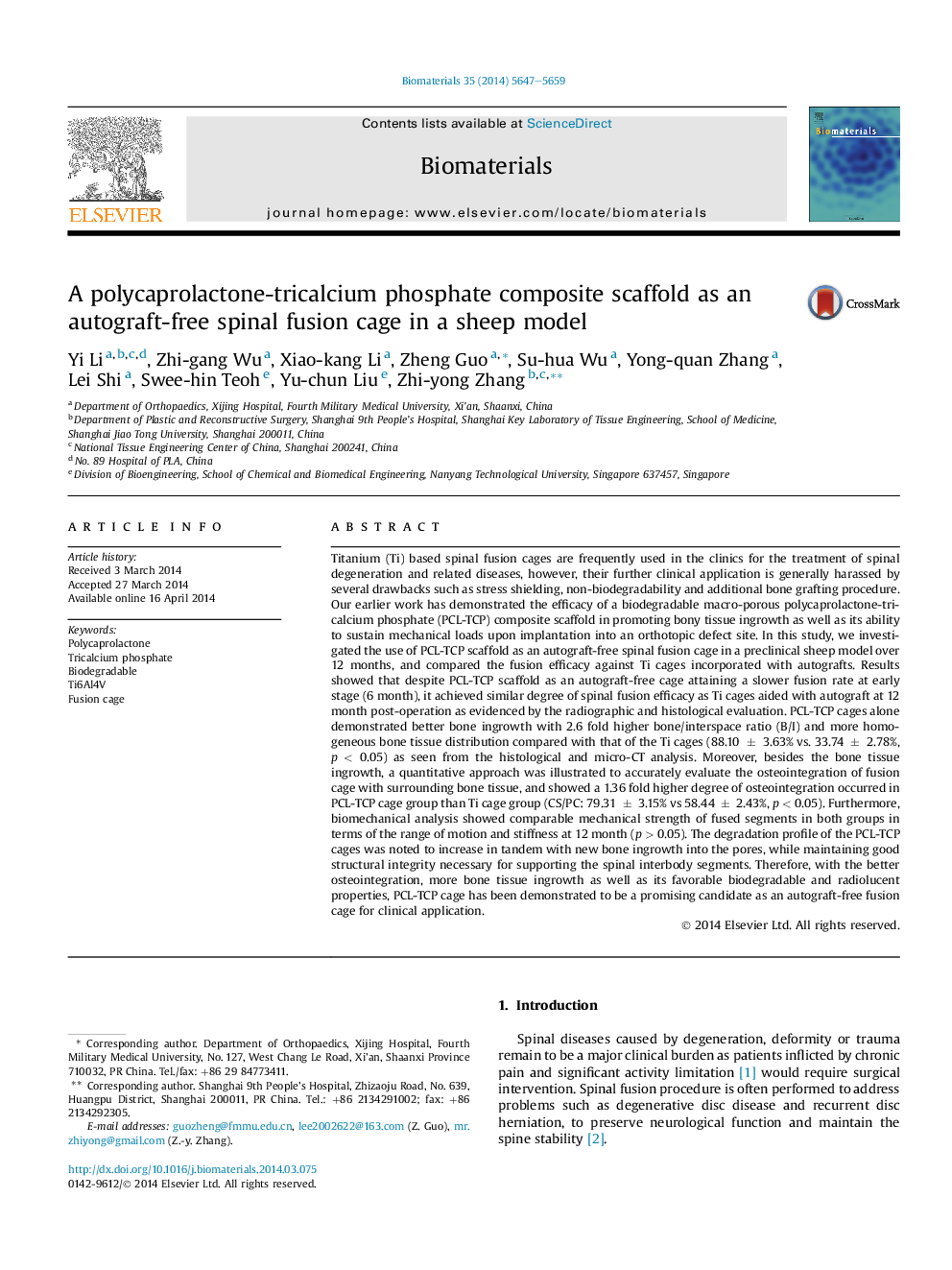| کد مقاله | کد نشریه | سال انتشار | مقاله انگلیسی | نسخه تمام متن |
|---|---|---|---|---|
| 10227706 | 459 | 2014 | 13 صفحه PDF | دانلود رایگان |
عنوان انگلیسی مقاله ISI
A polycaprolactone-tricalcium phosphate composite scaffold as an autograft-free spinal fusion cage in a sheep model
ترجمه فارسی عنوان
داربست کامپوزیتی پلی کاپرولاکتون-تری کلسیوم فسفات به عنوان قفس فیوژن ستون فقرات بدون جراحی در یک مدل گوسفند
دانلود مقاله + سفارش ترجمه
دانلود مقاله ISI انگلیسی
رایگان برای ایرانیان
کلمات کلیدی
موضوعات مرتبط
مهندسی و علوم پایه
مهندسی شیمی
بیو مهندسی (مهندسی زیستی)
چکیده انگلیسی
Titanium (Ti) based spinal fusion cages are frequently used in the clinics for the treatment of spinal degeneration and related diseases, however, their further clinical application is generally harassed by several drawbacks such as stress shielding, non-biodegradability and additional bone grafting procedure. Our earlier work has demonstrated the efficacy of a biodegradable macro-porous polycaprolactone-tricalcium phosphate (PCL-TCP) composite scaffold in promoting bony tissue ingrowth as well as its ability to sustain mechanical loads upon implantation into an orthotopic defect site. In this study, we investigated the use of PCL-TCP scaffold as an autograft-free spinal fusion cage in a preclinical sheep model over 12 months, and compared the fusion efficacy against Ti cages incorporated with autografts. Results showed that despite PCL-TCP scaffold as an autograft-free cage attaining a slower fusion rate at early stage (6 month), it achieved similar degree of spinal fusion efficacy as Ti cages aided with autograft at 12 month post-operation as evidenced by the radiographic and histological evaluation. PCL-TCP cages alone demonstrated better bone ingrowth with 2.6 fold higher bone/interspace ratio (B/I) and more homogeneous bone tissue distribution compared with that of the Ti cages (88.10  ±  3.63% vs. 33.74  ±  2.78%, p < 0.05) as seen from the histological and micro-CT analysis. Moreover, besides the bone tissue ingrowth, a quantitative approach was illustrated to accurately evaluate the osteointegration of fusion cage with surrounding bone tissue, and showed a 1.36 fold higher degree of osteointegration occurred in PCL-TCP cage group than Ti cage group (CS/PC: 79.31  ±  3.15% vs 58.44  ±  2.43%, p < 0.05). Furthermore, biomechanical analysis showed comparable mechanical strength of fused segments in both groups in terms of the range of motion and stiffness at 12 month (p > 0.05). The degradation profile of the PCL-TCP cages was noted to increase in tandem with new bone ingrowth into the pores, while maintaining good structural integrity necessary for supporting the spinal interbody segments. Therefore, with the better osteointegration, more bone tissue ingrowth as well as its favorable biodegradable and radiolucent properties, PCL-TCP cage has been demonstrated to be a promising candidate as an autograft-free fusion cage for clinical application.
ناشر
Database: Elsevier - ScienceDirect (ساینس دایرکت)
Journal: Biomaterials - Volume 35, Issue 22, July 2014, Pages 5647-5659
Journal: Biomaterials - Volume 35, Issue 22, July 2014, Pages 5647-5659
نویسندگان
Yi Li, Zhi-gang Wu, Xiao-kang Li, Zheng Guo, Su-hua Wu, Yong-quan Zhang, Lei Shi, Swee-hin Teoh, Yu-chun Liu, Zhi-yong Zhang,
